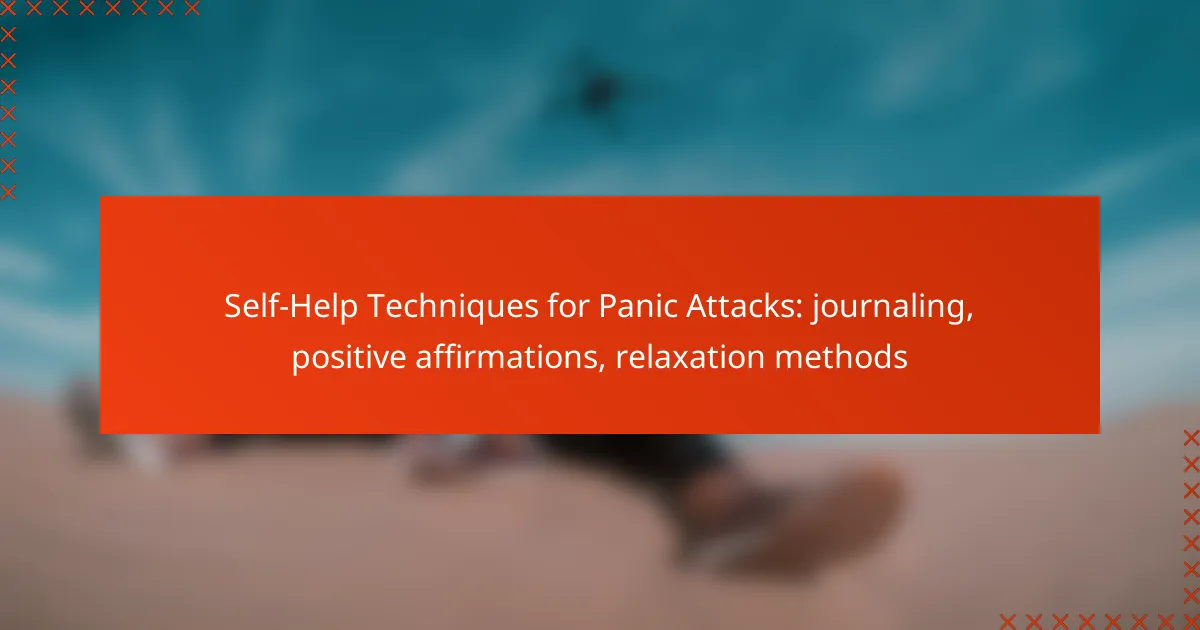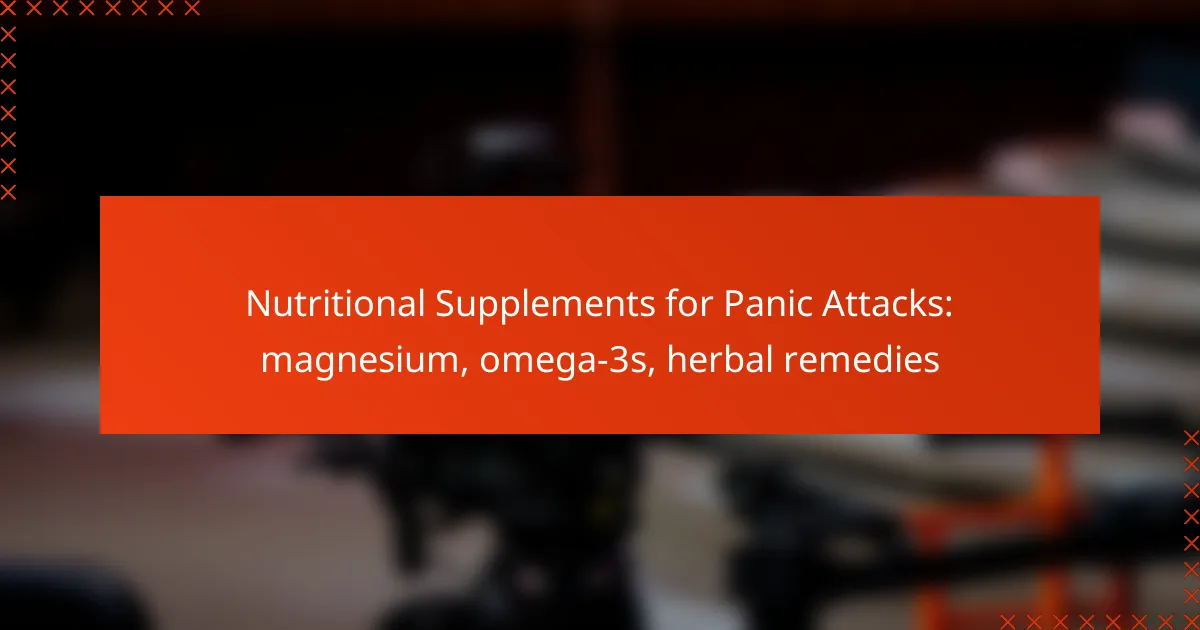Developing an effective emergency plan for panic attacks is crucial for managing symptoms and regaining control during distressing episodes. A personalized plan should outline specific action steps, include essential support contacts, and identify safe spaces to help alleviate anxiety. Incorporating coping strategies and safety measures, such as breathing techniques and grounding exercises, can significantly enhance one’s ability to navigate panic attacks with confidence.
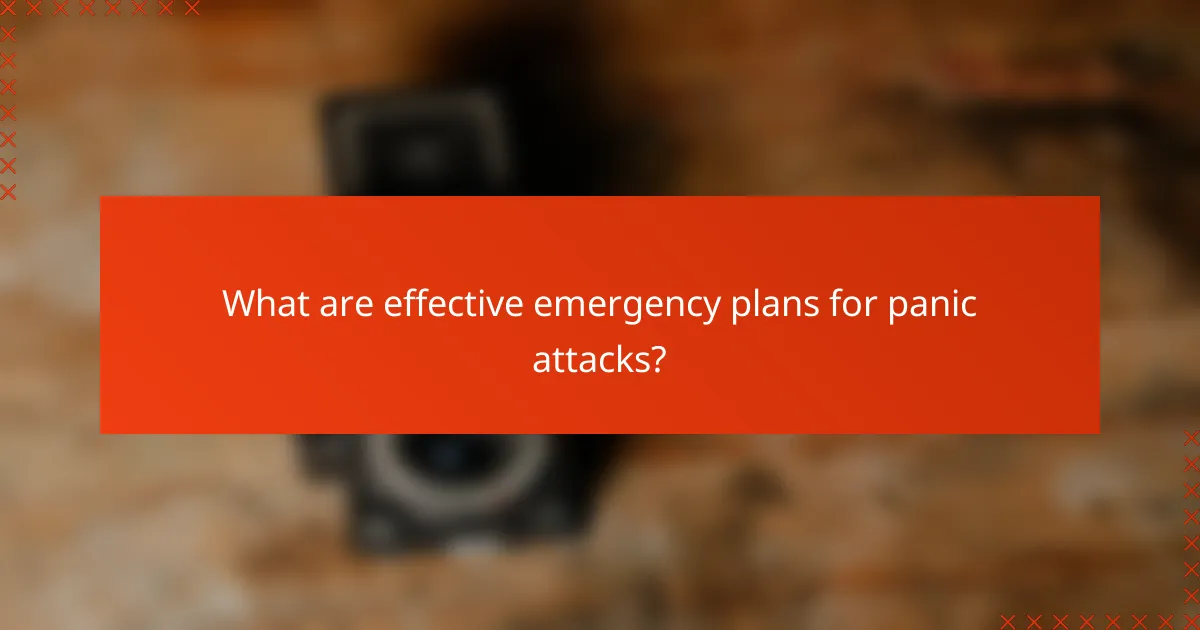
What are effective emergency plans for panic attacks?
Effective emergency plans for panic attacks involve clear steps that individuals can take to manage their symptoms and regain control. These plans should be personalized, include essential contacts, and identify safe spaces to help reduce anxiety during an episode.
Personalized action steps
Personalized action steps are crucial for managing panic attacks effectively. These steps may include deep breathing exercises, grounding techniques, or using positive affirmations to counter negative thoughts. It’s beneficial to practice these techniques regularly, so they become second nature during an attack.
Consider creating a checklist of your preferred coping strategies. For instance, you might list breathing exercises, visualization techniques, or a favorite calming mantra. Having this checklist handy can provide quick guidance when panic strikes.
Emergency contact list
An emergency contact list should include trusted individuals who can provide support during a panic attack. This may consist of family members, close friends, or mental health professionals who understand your situation. Make sure to keep their contact information easily accessible, such as in your phone or on a card in your wallet.
It’s advisable to have at least three contacts on your list, each with a specific role. For example, one person might be a calming presence, another could help you get to a safe space, and a third might provide professional support if needed. Regularly update this list to ensure that the contacts remain relevant and available.
Safe space identification
Identifying safe spaces is essential for managing panic attacks effectively. A safe space is a location where you feel secure and can calm down during an episode. This could be a quiet room at home, a favorite park, or even a specific corner in your workplace.
When choosing a safe space, consider factors such as accessibility, comfort, and privacy. It’s helpful to visit these spaces regularly, so they become associated with relaxation and safety. Additionally, practice visualization techniques that allow you to mentally retreat to your safe space when feeling overwhelmed.
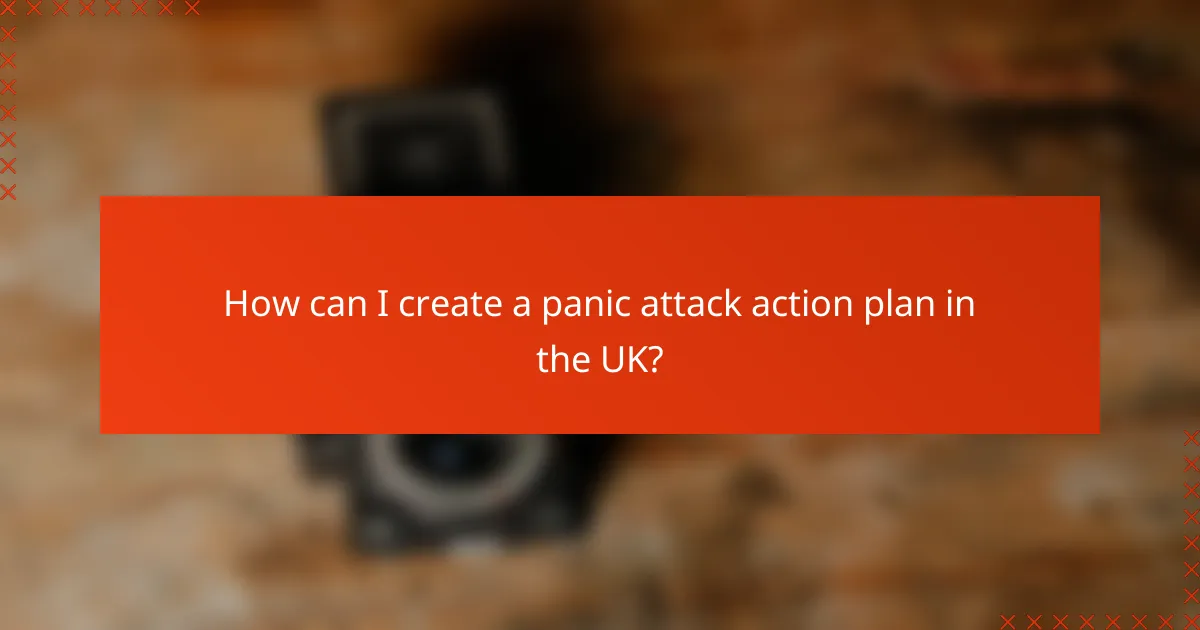
How can I create a panic attack action plan in the UK?
Creating a panic attack action plan in the UK involves outlining specific steps to manage symptoms effectively when they arise. This plan should include coping strategies, emergency contacts, and local resources to provide support during a panic attack.
Step-by-step guide
Start by identifying your triggers and symptoms. Write down what typically leads to a panic attack and how you feel when it happens. This awareness will help you recognize an impending attack and respond appropriately.
Next, develop a list of coping strategies that work for you. Techniques may include deep breathing exercises, grounding methods, or visualization. Practice these strategies regularly to ensure they are effective when needed.
Finally, create a contact list of trusted friends, family members, or mental health professionals who can provide support during a panic attack. Ensure this list is easily accessible, perhaps saved on your phone or written down in a visible place.
Local mental health resources
The UK offers various mental health resources for those experiencing panic attacks. The National Health Service (NHS) provides access to mental health services, including counseling and therapy options. You can find support through your local GP or mental health clinic.
Additionally, organizations like Mind and Samaritans offer helplines and support groups. These resources can provide immediate assistance and ongoing support tailored to your needs.
Consider joining local support groups where you can share experiences and coping strategies with others facing similar challenges. This community connection can be invaluable in managing panic attacks effectively.

What safety measures should be included in a panic attack plan?
A panic attack plan should include safety measures that help individuals manage symptoms effectively. Key components often involve breathing techniques, grounding exercises, and having a list of support contacts readily available.
Breathing techniques
Breathing techniques are essential for calming the body during a panic attack. Focused breathing, such as the 4-7-8 method, involves inhaling for four seconds, holding for seven seconds, and exhaling for eight seconds. This technique helps slow the heart rate and reduces anxiety.
Another effective method is diaphragmatic breathing, where you breathe deeply into your abdomen rather than your chest. This can be practiced by placing one hand on your chest and the other on your belly, ensuring the belly rises more than the chest. Aim for several minutes of this deep breathing to regain control.
Grounding exercises
Grounding exercises help redirect focus away from panic symptoms and back to the present moment. One popular technique is the 5-4-3-2-1 method, where you identify five things you can see, four things you can touch, three things you can hear, two things you can smell, and one thing you can taste. This sensory engagement can effectively reduce feelings of panic.
Another grounding exercise involves using an object, such as a small stone or a stress ball, to focus your attention. Hold the object and describe its texture, color, and weight to yourself. This simple act can help anchor you in reality and diminish overwhelming feelings during a panic attack.
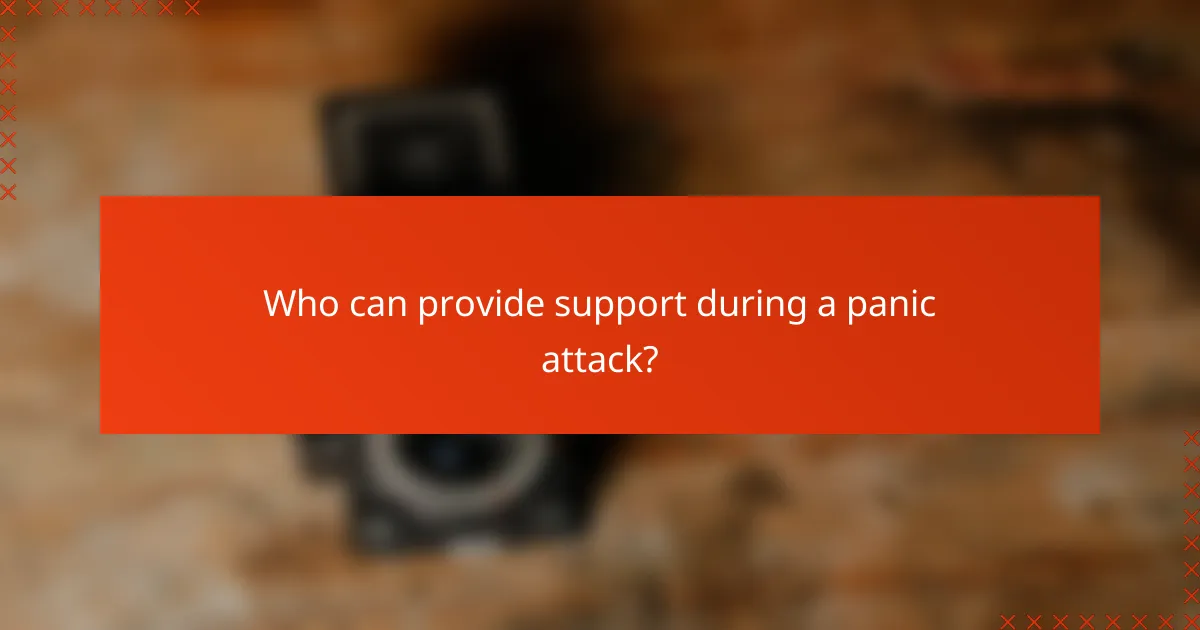
Who can provide support during a panic attack?
Support during a panic attack can come from trusted individuals and professionals who understand the situation. Having a reliable support system is essential for managing panic attacks effectively.
Trusted friends and family
Friends and family members who are aware of your panic attacks can offer immediate comfort and reassurance. They can help ground you by reminding you of your surroundings and encouraging you to focus on your breathing.
When reaching out to loved ones, communicate your needs clearly. Let them know how they can assist you during an attack, whether it’s by talking, staying silent, or helping you find a safe space.
Local mental health professionals
Local mental health professionals, such as therapists or counselors, can provide specialized support for managing panic attacks. They can offer coping strategies and therapeutic techniques tailored to your specific needs.
Consider scheduling regular sessions with a mental health expert who has experience in anxiety disorders. This ongoing support can help you build resilience and develop effective coping mechanisms over time.
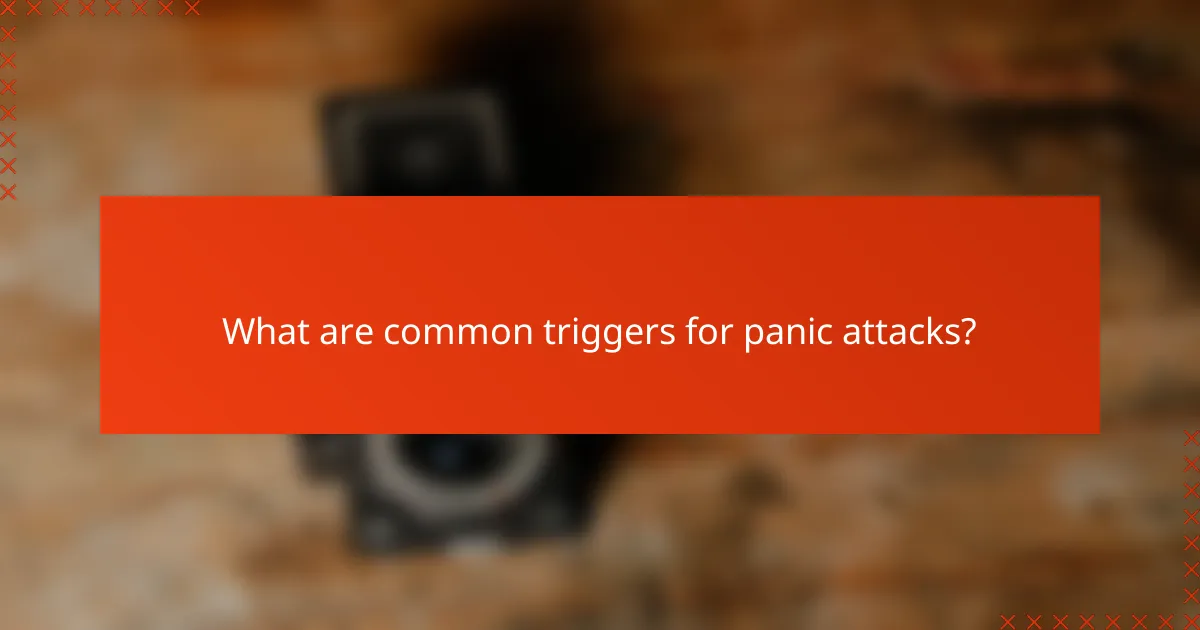
What are common triggers for panic attacks?
Panic attacks can be triggered by various factors that induce intense fear or anxiety. Understanding these triggers can help individuals manage their responses and develop effective coping strategies.
Environmental factors
Environmental factors can significantly contribute to the onset of panic attacks. Common triggers include crowded places, loud noises, or specific locations that may evoke past traumatic experiences. For instance, being in a confined space, like an elevator, may provoke feelings of helplessness and lead to a panic attack.
To mitigate the impact of environmental triggers, individuals can create a calming space at home or carry items that provide comfort, such as a stress ball or soothing music. It’s also helpful to practice grounding techniques, which can help refocus attention during overwhelming moments.
Stressful life events
Stressful life events are another common trigger for panic attacks. Situations such as job loss, relationship breakdowns, or the death of a loved one can heighten anxiety levels and lead to panic episodes. These events often create a sense of instability, making individuals more susceptible to panic.
To manage the effects of stressful life events, it’s crucial to establish a support network. This can include friends, family, or mental health professionals who can provide guidance and reassurance. Additionally, engaging in regular physical activity and mindfulness practices can help reduce overall stress and improve emotional resilience.

How can I educate others about my panic attack plan?
Educating others about your panic attack plan involves sharing clear information about your triggers, symptoms, and the steps they can take to support you during an episode. This proactive communication helps create a supportive environment and ensures that your contacts know how to respond effectively.
Informing close contacts
Start by having open conversations with family and friends about your panic attack plan. Explain what a panic attack feels like for you, including physical symptoms and emotional responses. Provide them with specific actions they can take, such as helping you find a quiet space or guiding you through breathing exercises.
Consider creating a simple handout that outlines your plan, including emergency contacts and any preferred coping strategies. This can serve as a quick reference for your close contacts in case of an emergency.
Workplace awareness initiatives
In the workplace, it’s essential to foster an environment where mental health is prioritized. Share your panic attack plan with your supervisor or HR department, and suggest implementing awareness initiatives such as training sessions on mental health first aid. These sessions can equip colleagues with the knowledge to support you and others facing similar challenges.
Encourage the establishment of a designated safe space within the office where employees can go if they feel overwhelmed. This proactive measure can help reduce anxiety and promote a culture of understanding and support.
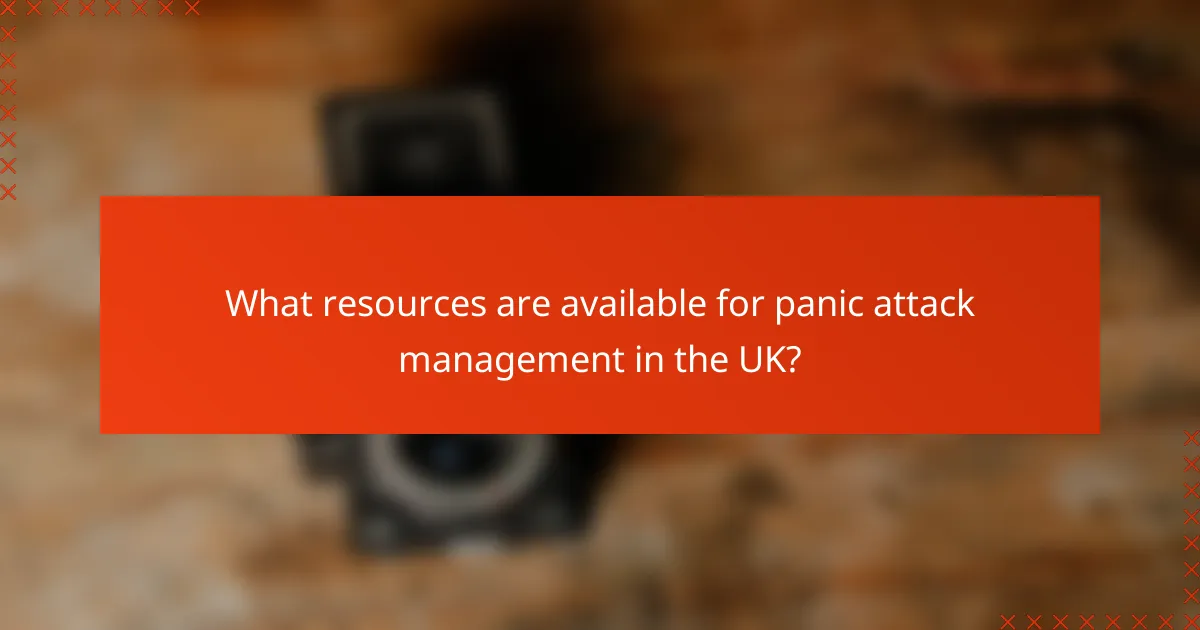
What resources are available for panic attack management in the UK?
In the UK, various resources are available to help manage panic attacks, including professional services, helplines, and online support. These resources can provide immediate assistance and long-term strategies for coping with panic attacks.
National Health Service (NHS) resources
The NHS offers a range of services for individuals experiencing panic attacks, including access to mental health professionals and community support. Patients can consult their GP for an assessment and referral to appropriate services, which may include therapy or medication.
Additionally, the NHS provides online resources such as self-help guides and information on coping strategies. The NHS website features a dedicated section on mental health, offering insights into panic attacks and how to manage them effectively.
For immediate support, individuals can contact NHS 111 for urgent advice or visit a local Accident & Emergency department if they feel overwhelmed. It is crucial to seek help early to prevent panic attacks from escalating.

